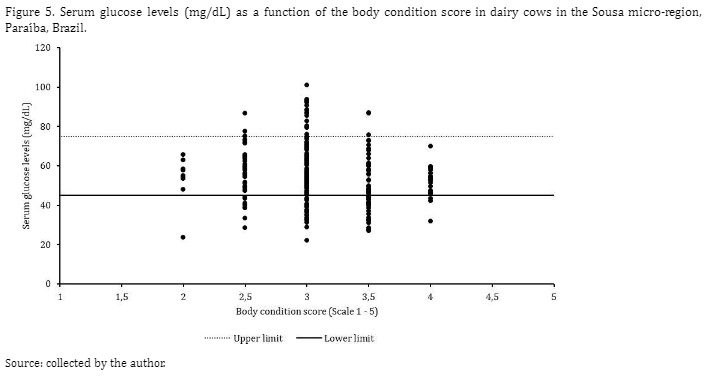Incidence of subclinical ketosis in dairy cows in the semi-arid region of the state of Paraíba
DOI:
https://doi.org/10.21708/avb.2023.17.3.12040Resumo
Subclinical ketosis (SCK) is one of the main metabolic diseases to occur during the transition period in dairy herds. The aim of this study was to evaluate the localized incidence of SCK in dairy cows in the semi-arid region of the state of Paraíba, Brazil, and to correlate this data with the number of weeks of lactation and the body condition score (BCS). Samples were collected from the coccygeal vein of 257 lactating dairy cows, with a view to determining serum ketone and glucose body levels. Animals that presented serum ketone body levels equal to or greater than 1.2 mmol/dL were considered to have SCK. It was found that 5.45% of the dairy cows presented SCK. The weeks of lactation and the BCS had no influence (P > 0.05) on the levels of serum ketone bodies or glucose of the dairy cows. For serum ketone body levels, 94.55% (243) of the cows remained within the normal limits for metabolites. Most of the cows, 67.70% (174) were within normal serum glucose levels, while 23.35% (60) presented hypoglycaemia, and 8.95% (23) presented hyperglycaemia. The BCS and serum glucose levels are negatively correlated, with a coefficient of -0.1329 (P = 0.0335). No significance was found 0.087 (P = 0.1608) for the correlation between the BCS and serum ketone body levels. The localized incidence of SCK in this study was 5.45% of the total number of cows, with the BCS and number of weeks of lactation having no influence on incidence of the disorder.
Downloads

Downloads
Publicado
Edição
Seção
Licença
Copyright (c) 2023 Acta Veterinaria Brasilica

Este trabalho está licenciado sob uma licença Creative Commons Attribution 4.0 International License.
Autores que publicam na Acta Veterinaria Brasilica concordam com os seguintes termos: a) Autores mantém os direitos autorais e concedem à revista o direito de primeira publicação, com o trabalho simultaneamente licenciado sob a Licença Creative Commons Attribution que permite o compartilhamento do trabalho com reconhecimento da autoria e publicação inicial nesta revista. b) Autores têm autorização para assumir contratos adicionais separadamente, para distribuição não-exclusiva da versão do trabalho publicada nesta revista (ex.: publicar em repositório institucional ou como capítulo de livro), com reconhecimento de autoria e publicação inicial nesta revista. c) Autores têm permissão e são estimulados a publicar e distribuir seu trabalho online (ex.: em repositórios institucionais ou na sua página pessoal) a qualquer ponto antes ou durante o processo editorial, já que isso pode gerar alterações produtivas, bem como aumentar o impacto e a citação do trabalho publicado (Veja O Efeito do Acesso Livre).


 Esta obra está licenciada com uma Licença
Esta obra está licenciada com uma Licença 